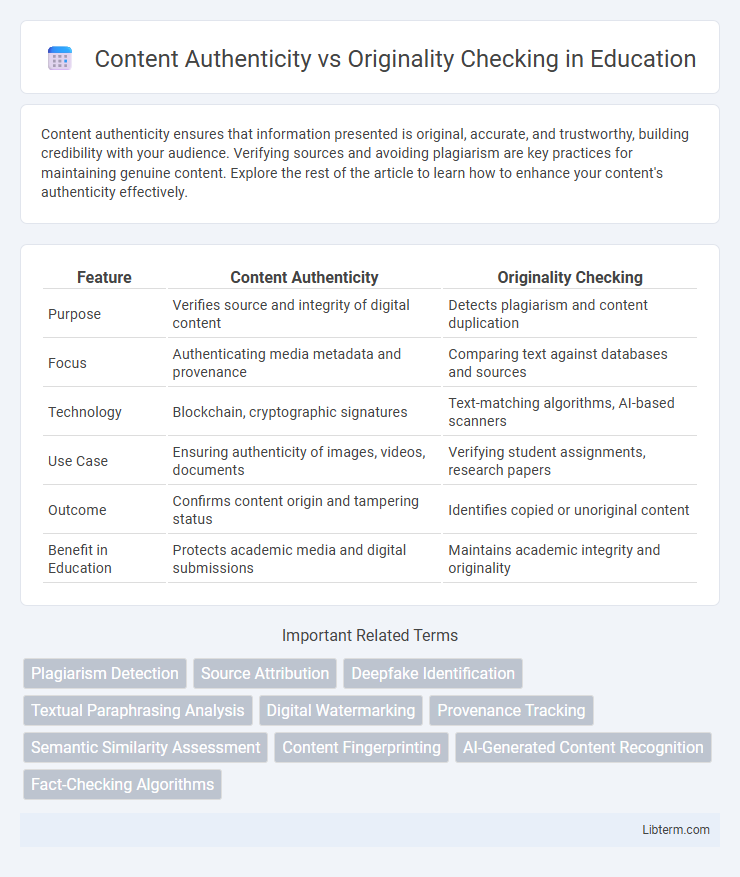Content authenticity ensures that information presented is original, accurate, and trustworthy, building credibility with your audience. Verifying sources and avoiding plagiarism are key practices for maintaining genuine content. Explore the rest of the article to learn how to enhance your content's authenticity effectively.
Table of Comparison
| Feature | Content Authenticity | Originality Checking |
|---|---|---|
| Purpose | Verifies source and integrity of digital content | Detects plagiarism and content duplication |
| Focus | Authenticating media metadata and provenance | Comparing text against databases and sources |
| Technology | Blockchain, cryptographic signatures | Text-matching algorithms, AI-based scanners |
| Use Case | Ensuring authenticity of images, videos, documents | Verifying student assignments, research papers |
| Outcome | Confirms content origin and tampering status | Identifies copied or unoriginal content |
| Benefit in Education | Protects academic media and digital submissions | Maintains academic integrity and originality |
Understanding Content Authenticity and Originality
Content authenticity ensures that the material is genuine, unaltered, and verifiable with a clear provenance, while originality checking evaluates whether the content is unique and not copied from other sources. Understanding content authenticity involves verifying the source, date, and integrity of information to prevent misinformation or forgery. Originality checking employs plagiarism detection algorithms and comparison with pre-existing databases to confirm that the content has not been replicated or closely imitated from existing works.
Importance of Authenticity in Digital Content
Content authenticity is crucial in digital media as it ensures the information is genuine, trustworthy, and free from manipulation or misrepresentation. Authentic digital content builds credibility, fosters user trust, and protects against misinformation, which is vital for brands, news outlets, and creators. Tools that verify authenticity help maintain integrity, prevent plagiarism, and support legal compliance in digital publishing.
Key Differences Between Authenticity and Originality
Content authenticity verifies the source and integrity of digital content to ensure it has not been altered or tampered with, often using metadata and cryptographic signatures. Originality checking assesses whether content is unique or duplicated by comparing it to existing materials, typically relying on plagiarism detection algorithms. The key difference lies in authenticity focusing on content provenance and tampering prevention, while originality centers on detecting copied or unoriginal material.
Methods for Checking Content Authenticity
Content authenticity is verified through methods such as digital watermarking, blockchain-based timestamping, and metadata analysis to ensure the source and integrity of the content remain intact. Techniques like reverse image search and forensic analysis detect manipulations or alterations in multimedia files. Authentication systems often utilize cryptographic signatures and hash functions to validate that content has not been tampered with since its creation.
Tools for Detecting Content Originality
Tools for detecting content originality utilize advanced algorithms and extensive databases to compare text against a multitude of sources, identifying potential plagiarism and duplicate content effectively. These solutions incorporate natural language processing and machine learning models to assess paraphrasing, citation accuracy, and content uniqueness with high precision. Popular tools such as Turnitin, Copyscape, and Grammarly provide comprehensive reports that help educators, publishers, and marketers ensure the authenticity and integrity of written work.
Common Challenges in Verifying Content Authenticity
Verifying content authenticity faces common challenges such as detecting deepfakes, manipulated images, and misinformation spread across social media platforms. The rapid evolution of AI-generated content and sophisticated editing tools complicates the identification of genuine sources and original authorship. Limited access to metadata and the absence of standardized verification protocols further hinder the accuracy and reliability of authenticity checks.
Risks of Relying Solely on Originality Checking
Relying solely on originality checking tools presents significant risks, including false positives and negatives that can misrepresent the authenticity of content. These tools often fail to detect nuanced forms of plagiarism, such as paraphrasing or idea theft, potentially allowing unoriginal work to go unnoticed. A comprehensive content authenticity strategy incorporates manual review and advanced semantic analysis to ensure genuine and trustworthy content verification.
Integrating Authenticity and Originality Checks
Integrating content authenticity and originality checks enhances digital content verification by simultaneously validating the source legitimacy and ensuring uniqueness across databases. This dual approach reduces misinformation and plagiarism by cross-referencing content against trusted databases and originality detection algorithms. Implementing combined tools supports content creators and platforms in maintaining integrity and trustworthiness in published materials.
Best Practices for Ensuring Genuine Content
Verifying content authenticity involves cross-referencing information with credible sources and utilizing digital watermarking or blockchain technology to confirm originality. Implementing plagiarism detection tools and metadata analysis helps identify copied or manipulated content effectively. Continuous monitoring and training creators on ethical standards are essential best practices to uphold genuine and trustworthy content in digital media.
Future Trends in Content Verification Technologies
Future trends in content verification technologies emphasize advanced AI-driven algorithms that enhance content authenticity checks by analyzing metadata, blockchain-based verification systems, and deep learning models to detect generated or manipulated content. Innovations in semantic analysis and natural language processing will improve originality checking by assessing contextual uniqueness rather than simple text matching. Integration of decentralized verification protocols is expected to increase transparency and trust in digital content across multiple platforms.
Content Authenticity Infographic

 libterm.com
libterm.com